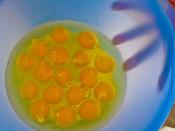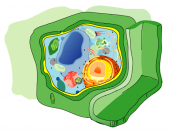Plant cells have a cell wall, large central vacuole, and plasmodesmata.
Like other eukaryotes, plants have a nucleus, plasma membrane, mitochondria, and other organelles, but plant cells differ from animal, fungal, and protist cells in a number of important ways. The most obvious difference is the presence of a cell wall which surrounds each cell. It is composed primarily of cellulose, a complex carbohydrate made from glucose. Cellulose provides structural support while remaining flexible; flower petals, for instance, are flexible but will snap if folded too far.
When plant cells divide, they must form a new cell wall between them, and this is accomplished by the formation of a phragmoplast, a system of microtubules oriented along the axis of cell division which helps to guide the deposition of cellulose. This is also an important difference from the "green algae", which produce a phycoplast during mitosis, in which the microtubules lie perpendicular to the axis of division.
Only plants and charophytes (green-algae) divide their cells with the aid of a phragmoplast.
Neighboring cells in plants are connected across their cell walls by extensions of the cells through pores called plasmodesmata. A plasmodesma allows cells to transfer nutrients, water, and some other diffusible materials without having to pass them across membranes or other barriers. They are also important for understanding how diseases spread through the tissues of a plant.
At maturity, most plant cells are filled with a single large vacuole, such that the nucleus, plastids, and other organelles are all close to the cell membrane. This can be seen in the picture at right. At the far right is the nearly transparent nucleus, and clusters of plastids can be seen toward the bottom and left. Those plastids which appear to be in the "middle" of the cell are...


